During the screw manufacturing process, screw fracture occurred during the straightening process.
To identify the root cause of screw fracture, the broken screw was subjected to macroscopic examination, chemical composition analysis, mechanical properties test, metallographic structure analysis, and fracture analysis.
The results indicate that the screw's internal casting defects were not eliminated due to inadequate hot forging during the manufacturing process, leading to reduced bearing capacity and cracking during the straightening process.
The task is to produce a batch of high-strength hexagonal screws with specifications of M42 mm, material of 42CrMoA and performance grade of 10.9.
The processing technology for screws is as follows: raw material annealing → centerless turning → sawing → flat end face chamfering → phosphating lubrication → shrink rod → hot forging → hex head chamfering → heat treatment (quenching) → straightening → thread rolling. The quenching process is handled by a mesh belt furnace.
During the straightening process, two screws broke approximately 1/2 of the screw axis (see Fig. 1).
The straightening process for the remaining screws from this batch was stopped immediately after two screws broke.
To identify the cause of screw fracture and prevent the recurrence of similar events, the author conducted a relevant inspection and analysis on the broken screws.
1. Physical and chemical tests
1.1 Macro inspection
1.1.1 Fracture macroanalysis
Both screws were broken off about half of the screw to straighten the bent part, as shown in Figure 1 (a).
The fracture surface presents brittle fracture characteristics as a whole. Radial streaks are visible on the fracture surface extending from the center to the periphery.
The outer layer of the fracture surface appears smooth and flat, indicating brittle fracture.
No macroscopic plastic deformation or slag inclusion was detected on the fracture surface.
As shown by the arrow in Figure 2, cracks were found during the straightening process. The cracks started in the center and spread to the periphery, eventually resulting in screw fracture.
1.1.2 Macroscopic test
For low magnification inspection, a cross-sectional sample should be collected 20 mm below the fracture surface of the broken screw.
Numerous shrinkage cavities are discovered in the center of the screw.
According to the inspection results, the overall laxity is classified as Grade 1, the central laxity as Grade 2, and the overall speckled segregation as less than Grade 1.
See Figure 3 for details. No other macro defects, such as cracks, were detected.
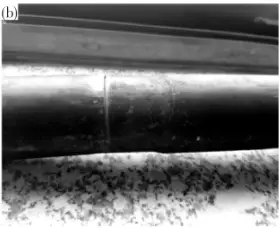
Fig.1 Broken screw
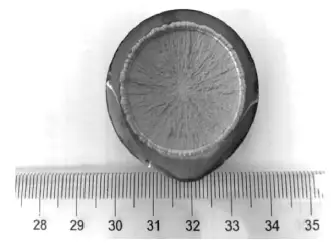
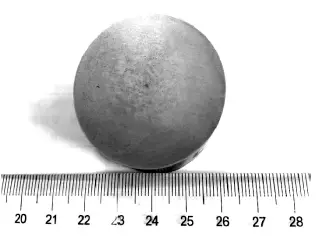
1.2 Analysis of chemical composition
Please collect approximately 20 mm samples near the screw fracture position for chemical composition analysis.
For this task, we will use the QSN750 direct reading spectrometer produced by OBLF in Germany. The chemical composition of the material will be tested to ensure that it meets the requirements of GB/T 3077-1999 Alloy Structural Steel for the chemical composition of screws of this material by spectral analysis. See Table 1 for results.
To determine the oxygen, nitrogen and hydrogen content of the sample taken from the broken bolt, we will use the ONH-836 oxygen, nitrogen and hydrogen analyzer from American Liko Company. According to the analysis results, the content of oxygen, nitrogen and hydrogen is 0.0011%, 0.0090% and 0.0001%, respectively.
It is important to note that the content levels of O, N and H are low.
Table 1 Chemical composition of the broken screw (w,%)
| Element | W | Yes | Mn | P | s | Cr | Mo | No | Ass |
| Detection value | 0.42 | 0.34 | 0.69 | 0.010 | 0.004 | 1.10 | 0.20 | 0.04 | 0.02 |
| 0.43 | 0.33 | 0.70 | 0.010 | 0.006 | 1.07 | 0.20 | 0.04 | 0.02 | |
| 0.39 | 0.33 | 0.67 | 0.010 | 0.004 | 1.06 | 0.19 | 0.04 | 0.02 | |
| Standard value | 0.38-0.45 | 0.17-0.37 | 0.50-0.80 | 0.025 | 0.025 | 0.90~1.20 | 0.13~0.25 | <0.30 | <0.25 |
1.3 Mechanical properties
Select a bolt from the same batch for the pull test.
The diameter of the pull sample is 10mm, but it is not the actual screw.
Wance Group's HUT605A microcomputer-controlled electro-hydraulic universal servo testing machine is used to conduct mechanical performance testing.
See Table 2 for test results.
The hardness test is carried out on the metallographic sample of the broken screw and the test results are presented in Table 3.
There is no significant difference in hardness between the surface and the center of the bolt, and the mechanical property test results meet the requirements of Mechanical Properties of Fasteners – Bolts, Screws and Studs (GB/T 3098.1-2010).
Table 2 Mechanical properties test result
| properties | Tensile strength Rm/MPa | Yield limit Rel/MPa | Elongation A/% | Reduction of area Z/% |
| Detection value | 1069 | 970 | 14.6 | 53.5 |
| Standard value | ≥1040 | ≥940 | ≥9 | ≥48 |
Table 3 Hardness test result
| Paper | Surface/HBW | Core/HBW |
| Detection value | 333,329,337 | 321、329、329 |
| Standard value | 316~375 | |
1.4 Microstructural analysis
Metallographic samples were taken from the surface and core near the fracture of the broken bolt, and a metallographic inspection was performed using an OLYMPUS-GX51 metallographic microscope.
After polishing, numerous holes were observed in the center, as illustrated in Figure 3 (a), and no apparent abnormalities were found on the surface.
The microstructure of the screw surface and core was tempered sorbite.
The microstructure near the surface had a relatively small number of holes, as shown in Figure 3 (b).
The microstructure in the core had a relatively large number of holes, as shown in Figure 3 (c). No visible decarburization was found on the screw surface, as shown in Figure 3 (d).
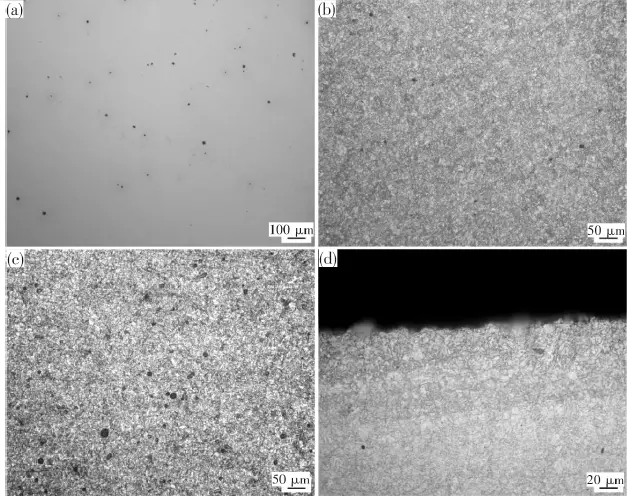
- (a)Polish state;
- (b)near the sun face;
- (c)core;
- (d)surface
Fig.4 Screw fracture microstructure
1.5 Analysis of fracture morphology
After ultrasonic cleaning, the IT300 scanning electron microscope was used to analyze the fracture morphology.
Observation of the SEM morphology in the radial area of the fracture surface shows that the fracture surface exhibits obvious characteristics of cleavage fracture, and there are secondary cracks and a small number of holes in localized locations, as shown in Figure 4.
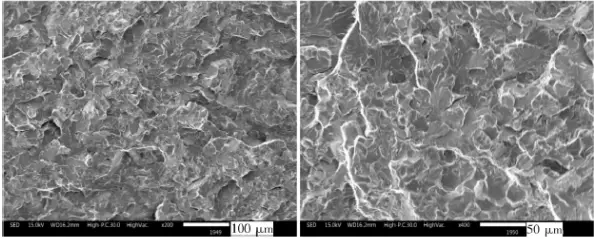
Fig.5 SEM fracture morphology
2. Comprehensive analysis
The chemical composition of the broken screw meets the requirements of the standard. The fracture presents transverse cracks and macroanalysis of the fracture surface indicates that it has brittle fracture characteristics.
The fracture surface has two parts: the crack origin area in the center of the fracture surface and the radial expansion area from the center to the periphery. There is no plastic deformation at the fracture edge, indicating brittle fracture characteristics.
At low magnification, a serious center gap problem (center gap level 2) was found on the test surface. During the casting process, the loose system gradually solidifies the molten steel from the surface to the center, and the columnar crystalline area grows toward the center in the form of dendrites.
The first crystallized dendrites are relatively pure and have a high melting point. Segregated elements, gases, non-metallic inclusions and a small amount of non-solidified molten steel are enriched between the dendrites.
As the temperature decreases, the solidified part shrinks. When there is insufficient unsolidified molten steel between the dendrites to fill the gap, shrinkage cavities form. Loose defects are called general looseness. When porosity occurs in the central equiaxed area, it is called central porosity. Metallographic test results show small holes consistent with low magnification test results.
Fracture analysis shows the morphology of the cleavage fracture, and there are secondary cracks and a small number of holes on the fracture surface. The mechanical property test results meet relevant standard requirements.
Therefore, the fracture presents transverse cracking and the microstructure indexes and mechanical properties meet the requirements of the standard. Furthermore, the bolt breakage was not caused by quenching and tempering since a mesh belt furnace was used in the process and there was no premature tempering.
The crack originated from the center and progressed outward. The hydrogen content was insufficient to cause hydrogen embrittlement, and no hydrogen embrittlement features (chicken claw pattern) were found in the SEM photos. Therefore, the bolt crack was not caused by hydrogen-induced delayed cracking.
Low-magnification inspection revealed obvious central looseness in the center of the bolt, which is consistent with the position of the crack origin on the fracture surface. The fracture system is transversely cracked, indicating the presence of axial tensile stress during cracking.
Therefore, based on the screw manufacturing process, it can be determined that the screw had center play due to defects in the raw material.
In the hot forging process, casting defects were not eliminated, and under the continuous axial tensile stress in the rod shrinkage process, the holes in the screw initiated cracks that gradually expanded outward. Brittle cracks occurred during the straightening process, resulting in screw failure.
3. Conclusion is ion
The root cause of screw fracture is the presence of casting defects (central looseness) in the screw blank that were not eliminated during the hot forging process, resulting in a reduced load capacity of the screw. The cracks then occurred under tensile force during the correction process.
























































